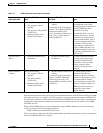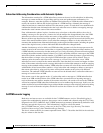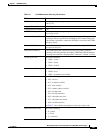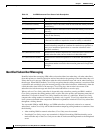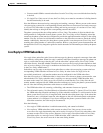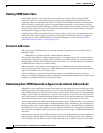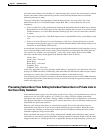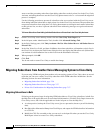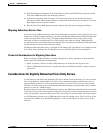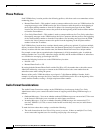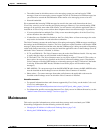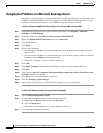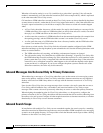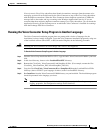
7-57
Networking Guide for Cisco Unity Release 5.x (With Microsoft Exchange)
OL-13844-01
Chapter 7 VPIM Networking
VPIM Concepts and Definitions
4. Run Global Subscriber Manager from Tools Depot to delete the VPIM delivery locations and the
associated VPIM subscribers and underlying contacts.
5. If the people migrating from the remote voice messaging system do not already have Active
Directory accounts and Exchange mailboxes, create them. Alternatively, you can let the Cisco
Unity
Bulk Import wizard create the accounts.
6. Run the Cisco Unity Bulk Import wizard by using the input file that you prepared in Step 3.
Migrating Subscribers One at a Time
If you have set up VPIM subscriber accounts for the subscribers on another voice messaging system, and
if they have existing Exchange mailboxes, you can use the Migrate Subscriber Data utility when the time
comes to migrate them to Cisco
Unity. The Migrate Subscriber Data utility creates a Cisco Unity
subscriber account by combining the Cisco
Unity-specific data from an existing VPIM subscriber
account (such as the voice name) with an existing mail user. The utility then deletes the VPIM subscriber
account and the associated Active Directory contact.
The Migrate Subscriber Data utility is available in Tools Depot (the Tools Depot icon is installed on the
Cisco
Unity server desktop). See the Help file that comes with the utility for more information.
Private List Considerations for Migrating Subscribers
When you migrate VPIM subscribers, consider notifying Cisco Unity subscribers of these potential
effects on private distribution list membership:
• When you delete a delivery location, blind addressees are removed from all private lists.
• When a VPIM subscriber becomes a regular subscriber, the VPIM subscriber is removed from all
private lists.
Considerations for Digitally Networked Cisco Unity Servers
A small subset of subscriber and distribution list data is stored in Active Directory, as is most location
data. In organizations with multiple Cisco
Unity servers networked together such that they access a
common directory, the Cisco
Unity-specific data replicates to all Cisco Unity servers in the network.
Therefore, all Cisco
Unity servers on the network have the information that subscribers need to address
messages to users at a VPIM location.
Because of directory replication, VPIM delivery locations and VPIM subscribers need to be created only
on one Cisco
Unity server in the network. If allowed by the primary location addressing options on each
server, all subscribers, no matter which Cisco
Unity server they are associated with, can send messages
to a VPIM delivery location or to a VPIM subscriber created on another server. The Cisco
Unity server
configured for VPIM acts as the VPIM “bridgehead” server for the other Cisco
Unity servers in the
network.



